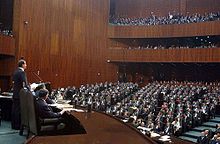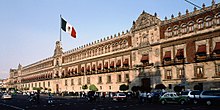Federal government of Mexico
 |
|---|
|
|
The Federal government of Mexico is the Federal Government of the United Mexican States, the central government established by the Constitution of the United Mexican States to share sovereignty over the United Mexican States with the governments of the individual 31 Mexican states and to represent such governments before international bodies such as the United Nations. The Mexican federal government has three branches: executive, legislative, and judicial. Through the system of separation of powers each of these branches has some authority to act on its own, some authority to regulate the other two branches, and has some of its own authority is regulated by the other branches. The seat of the federal government is in the Distrito Federal, or simply, "D.F."
Mexico's government takes place in a framework of a federal presidential representative democratic republic whose government is based on a congressional system, whereby the president of Mexico is both head of state and head of government, and of a multi-party electoral system. The federal government functions per the Political Constitution of the United Mexican States, as enacted in 1917, and as ammended.
The executive power is exercised by the executive branch, which is headed by the President, advised by a cabinet of secretaries that are independent of the legislature. Legislative power is vested upon the Congress of the Union a two-chamber legislature comprising the Senate and the Chamber of Deputies. Judicial power is exercised by the judiciary, comprising of the Supreme Court of Justice of the Nation, the Council of the Federal Judiciary and the collegiate, unitary and district tribunals.
The Powers of the Union
The federal government, known as the Supreme Power of the Federation, is constituted by the Powers of the Union: the legislative, the executive, and the judicial. Mexico City, as the capital of the federation is the Federal District, the seat of the powers of the Union. All branches of government are independent; no two separate branches must be vested upon a single person or institution, and the legislative power must not be vested upon single individual.
Legislative branch

The legislative power[1] is vested upon the Congress of the Union, a bicameral congress comprising the Senate (Spanish: Cámara de Senadores or Senado) and the Chamber of Deputies (Spanish: Cámara de Diputados). The powers of the Congress include the right to pass laws, impose taxes, declare war, approve the national budget, approve or reject treaties and conventions made with foreign countries, and ratify diplomatic appointments. The Senate addresses all matters concerning foreign policy, approves international agreements, and confirms presidential appointments. The Chamber of Deputies addresses all matters pertaining to the government's budget and public expenditures.


The Chamber of Deputies is formed by 500 representatives of the nation. All deputies are elected in free universal elections every three years, in parallel voting: 300 deputies are elected in single-seat constituencies by first-past-the-post plurality (called uninominal deputies), and the remaining 200 are elected by the principle of proportional representation (called plurinominal deputies) with open-party lists for which the country is divided into five constituencies or plurinominal circumscriptions. Deputies cannot be reelected for the next immediate term.
Being a supplementary system (PM) of parallel voting, proportionality is only confined to the plurinominal seats. However, to prevent a party to be overrepresented, several restrictions to the assignation of plurinominal seats are applied:
- A party must obtain at least 2% of votes to be assigned a plurinominal seat;
- No party can have more than 300 seats (uninominal and plurinominal together), even if the party gets more than 52% of the votes;
- No party can have more deputies (uninominal and plurinominal) whose proportion in the Chamber is eight percentage points greater than the percentage of votes obtained in the elections;
The Senate consists of 128 representatives of the constituent states of the federation. All senators are elected in free universal elections every six years through a parallel voting system as well: 64 senators are elected by first-past-the-post plurality, two per state and two for the Federal District elected jointly; 32 senators are assigned through the principle of "first minority", that is, they are awarded to the first runner-up party for each constituent state and the Federal District; and 32 are elected by proportional representation with open-party lists, for which the country forms a single constituency. Senators cannot be reelected for the next immediate term.
Executive branch

The executive power[2] is vested upon a single individual, the president of the United Mexican States, elected by first-past-the-post plurality for a 6 year term (called sexenio), without the possibility of reelection. There is no office for a vice-president; in case of "absolute absence" or incapacity of the President, the Congress of the Union (with a quorum of at least two-third of all representatives) will be constituted as an Electoral College which will elect by absolute majority an interim president. If the absolute absence occurred during the first two years of the sexenio, the Congress will also call elections in no less than 14 and no more than 18 months after the inauguration of the interim president. If the absolute absence of the presidents occurred during the last four years of the sexenio, then the interim president will serve for the remaining years of the absent president's term.
The President also appoints, with Senate approval, the Cabinet members and other officers. The President is responsible of executing and enforcing the law, and has the authority of vetoing bills.
Judicial branch
The judiciary[3] consists of The Supreme Court of Justice, composed of eleven judges or ministers appointed by the President with Congress approval, who interpret laws and judge cases of federal competency. Other institutions of the judiciary are the Electoral Tribunal, collegiate, unitary and district tribunals, and the Council of the Federal Judiciary. The ministers of the Supreme Court will serve for 15 years and cannot be appointed to serve more than once.
The Federal District
Mexico City does not belong to any state in particular, but to the federation, being the capital of the country and seat of the powers of the Union. As such, it is constituted as a Federal District, ultimately administered by the Powers of the Union.[4] Nonetheless, since the late 1990s certain autonomy and powers have been gradually devolved. The executive power is vested upon a head of government now elected by first-past-the-post plurality. The legislative power is vested upon a unicameral Legislative Assembly. The judicial power is exercised by the Supreme Tribunal of Justice and the Judiciary Council.
The Federal District is divided into delegaciones or boroughs. Though not fully equivalent to a municipality in that they do not have regulatory powers, they have gained limited autonomy in recent years, and the representatives to the head of government are now elected by the citizens as well.
References and notes
- ^ The composition, responsibilities and requirements of the legislative power are outlined in articles 50 to 79 of the Political Constitution of the United Mexican States
- ^ The composition, responsibilities and requirements of the executive power are outlined in articles 80 to 93 of the Political Constitution of the United Mexican States
- ^ The composition, responsibilities and requirements of the judicial power are outlined in articles 94 to 107of the Political Constitution of the United Mexican States
- ^ The form of government of the Federal District is outlined in the 112nd article of the Political Constitution of the United Mexican States.
